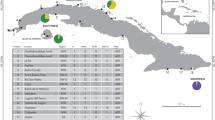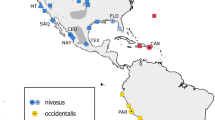Abstract
Tuatara (Sphenodon spp) populations are restricted to 35 offshore islands in the Hauraki Gulf, Bay of Plenty and Cook Strait of New Zealand. Low levels of genetic variation have previously been revealed by allozyme and mtDNA analyses. In this new study, we show that six polymorphic microsatellite loci display high levels of genetic variation in 14 populations across the geographic range of tuatara. These populations are characterised by disjunct allele frequency spectra with high numbers of private alleles. High F ST (0.26) values indicate marked population structure and assignment tests allocate 96% of all individuals to their source populations. These genetic data confirm that islands support genetically distinct populations. Principal component analysis and allelic sequence data supplied information about genetic relationships between populations. Low numbers of rare alleles and low allelic richness identified populations with reduced genetic diversity. Little Barrier Island has very low numbers of old tuatara which have retained some relictual diversity. North Brother Island’s tuatara population is inbred with fixed alleles at 5 of the 6 loci.
Similar content being viewed by others
References
Aitken N, Hay JM, Sarre SD, Lambert DM, Daugherty CH (2001) Microsatellite DNA markers for tuatara (Sphenodon spp). Conserv Genet 2:183–185
Angers B, Bernatchez L (1998) Combined use of SMM and non-SMM methods to infer fine structure and evolutionary history of closely related Brook Charr (Salvelinus fontinalis, Salmonidae) populations from microsatellites. Mol Biol Evol 15:143–159
Brzustowski J (2002) Doh assignment test calculator. http://www.2biology.ualberta.ca/jbrzusto/Doh.php
Buller WL (1877) Notes on the tuatara lizard (Sphenodon punctatus), with a description of a supposed new species. Trans Proc NZ Inst 1876 9:317–325
Buller WL (1879) Further notes on the habits of the tuatara lizard. Trans Proc NZ Inst 1878 11:349–351
Chambers GK, MacAvoy ES (2000) Microsatellites: consensus and controversy. Comparat Biochem Physiol Part B 126:455–476
Chambers GK, MacAvoy ES (2004) The mutational dynamics and evolution of DNA microsatellites. In: Paroso V, DeFonzo V, Aluffi-Pentini F (eds) Dynamical genetics. Research Signpost, India, pp 133–152
Ciofi C, Bruford MW (1999) Genetic structure and gene flow among Komodo dragon populations inferred by microsatellite loci analysis. Mol Ecol 8:S17–S30
Ciofi C, Milinkovitch MC, Gibbs JP, Caccone A, Powell JR (2002) Microsatellite analysis of genetic divergence among populations of giant Galápagos tortoises. Mol Ecol 11:2265–2283
Cornuet J-M, Luikart G (1996) Description and power analysis of two tests for detecting recent population bottlenecks from allele frequency data. Genetics 144:2001–14
Cree A (1994) Low annual reproductive output in female reptiles from New Zealand. NZ J Zool 21:351–372
Cree A, Butler D (1993) Tuatara Recovery Plan (Sphenodon spp.) Threatened species recovery plan series No.9. Department of Conservation, Wellington
Cunningham J, Baard EHW, Harley EH, O’Ryan C (2002) Investigation of genetic diversity in fragmented geometric tortoise (Psammobates geometricus) populations. Conserv Genet 3:215–223
Daugherty CH, Cree A, Hay JM, Thompson MB (1990) Neglected taxonomy and continuing extinctions of tuatara (Sphenodon). Nature 347:177–179
Finch MO, Lambert DM (1996) Kinship and genetic divergence among populations of tuatara Sphenodon punctatus as revealed by minisatellite DNA profiling. Mol Ecol 5:651–658
Frankham R, Ballou JD, Briscoe DA (2002) Introduction to conservation genetics. Cambridge University Press, Cambridge
Garza JC, Williamson EG (2001) Detection of reduction in population size using data from microsatellite loci. Mol Ecol 10:305–318
Gaze P (2001) Tuatara recovery plan, 2001–2011. Threatened species recovery plan No. 47, Department of Conservation, Wellington
Goldstein DB, Pollock DD (1997) Launching microsatellites: a␣review of mutation processes and methods of phylogenetic inference. J Heredity 88:335–342
Goldstein DB, Schlötterer C (1999) Microsatellites: evolution and applications. Oxford University Press, Oxford
Goodman SJ (1997) RST Calc: a collection of computer programs for calculating estimates of genetic differentiation from microsatellite data and determining their significance. Mol Ecol 6:881–885
Goudet J (2001) FSTAT, a program to estimate and test gene diversities and fixation indices (version 2.9.3.2). Available from http://www.unil.ch/izea/software/fstat.html
Guo SW, Thompson EA (1992) Performing the exact test of Hardy-Weinberg proportion for multiple alleles. Biometrics 48:361–372
Hay JM, Daugherty CH, Cree A, Maxson LR (2003) Low genetic divergence obscures phylogeny among populations of Sphenodon, remnant of an ancient reptile lineage. Mol Phylogenet Evol 29:1–19
Hayward BW (1986) Origin of the offshore islands of northern New Zealand and their landform development. In: Weight AE, Beever RE (eds) The offshore islands of northern New Zealand, New Zealand Department of Lands and Survey Information Series No. 16, Wellington
Hoare JM (2002) Biological and environmental influences on body condition of the Brothers Island tuatara, Sphenodon guntheri. Thesis for Bachelor of Science (Honours) in Ecology and Biodiversity, Victoria University of Wellington, New Zealand
Luikart GW, Allendorf FW, Cornuet J-M, Sherwin WB (1998) Distortion of allele frequency distributions provides a test for recent population bottlenecks. J Heredity 89:238–247
Nelson NJ, Keall SN, Brown D, Daugherty CH (2002a) Establishing a new wild population of tuatara (Sphenodon guntheri). Conserv Biol 16:887–894
Nelson NJ, Keall SN, Pledger S, Daugherty CD (2002b) Male-biased sex ratio in a small tuatara population. J Biogeogr 29:633–640
Newman AK (1878) Notes on the physiology and anatomy of the tuatara (Sphenodon punctatus). Trans Proc NZ Inst 10:222–239
Paetkau D, Calvert W, Sterling I, Strobeck C (1995) Microsatellite analysis of population structure in Canadian polar bears. Mol Ecol 4:347–354
Peakall R, Gilmore S, Keys W, Morgante M, Rafalski A (1998) Cross-species amplification of soybean (Glycine max) simple sequence repeats (SSRs) within the genus and other legume genera: implications for the transferability of SSRs in plants. Mol Biol Evol 15:1275–1287
Peakall R, Smouse PE (2001) GenAlEx v5.04: Genetic Analysis in Excel. Subpopulation Genetics Software for Teaching and Research. Australian National University, Canberra, Australia. Available at: http://www.anu.edu.au/BoZo/GenAlEx/
Pemberton JM, Slate J, Bancroft DR, Barrett JA (1995) Nonamplifying alleles at microsatellite loci: a caution for parentage and population studies. Mol Ecol 4:249–252
Petit RJ, El Mousadik A, Pons O (1998) Identifying populations for conservation on the basis of genetic markers. Conserv Biol 12:844–855
Piry S, Luikart G, Cornuet J-M (1999) BOTTLENECK: a computer program for detecting recent reductions in the effective population size using allele frequency data. J Heredity 90:502–503
Pritchard JK, Stephens M, Donnelly P (2000) Inference of population structure using multilocus genotype data. Genetics 155:945–959
Randi E, Lucchini V (2002) Detecting rare introgression of domestic dog genes into wild wolf (Canis lupus) populations by Bayesian admixture analyses of microsatellite variation. Conserv Genet 3:31–45
Randi E, Pierpaoli M, Beaumont M, Ragni B, Sforzi A (2001) Genetic identification of wild and domestic cats (Felis silvestris) and their hybrids using Bayesian clustering methods. Mol Biol Evol 18:1679–1693
Rassmann K, Tautz D, Trillmich F, Gliddon C (1997) The microevolution of the Galápagos marine iguana Amblyrhynchus cristatus assessed by nuclear and mitochondrial genetic analyses. Mol Ecol 6:437–452
Raymond M, Rousset F (1995a) GENEPOP (version 1.2): Population genetics software for exact tests and ecumenicism. J␣Heredity 86:248–249
Raymond M, Rousset F (1995b) An exact test for population differentiation. Evolution 49:1280–1283
Rice WR (1989) Analysing tables of statistical tests. Evolution 43:223–225
Sambrook F, Fitsch EF, Maniatis T (1989) Molecular cloning: a laboratory manual. 2nd edn. Cold Spring Harbour Laboratory Press
Slatkin M (1995) A measure of population subdivision based on microsatellite allele frequencies. Genetics 139:457–462
Sunnucks P (2000) Efficient genetic markers for population biology. Trends Ecol Evol 15:199–203
Waples RS (1987) A multispecies approach to the analysis of gene flow in marine shore fishes. Evolution 41:385–400
Weir BS, Cockerham CC (1984) Estimating F-Statistics for the analysis of population structure. Evolution 38:1358–1370
Wright S (1951) The genetical structure of populations. Annals Eugenics 15:323–354
Yeh FC, Yang RC, Boyle T (1999) POPGENE version 1.32, the user friendly software for population genetic analysis. Molecular Biology and Biotechnology Centre, University of Alberta, Canada
Acknowledgements
We thank the teams of biologists from Victoria University, the Department of Conservation and numerous volunteers who collected the tuatara samples. We also thank Dr Jenny Hay for donating the North and South Trios DNA samples we used and Sue Keall, Dr Nicky Nelson, Kelly Hare and Joanna Hoare for providing historical and biological information about tuatara on North Brother Island and translocations. We are grateful to Rod Lea who introduced us to the Structure analysis program and to Lesley Milicich who helped with DNA sequencing runs during the early development of the microsatellites. This study was supported by the Victoria University of Wellington Research Fund.
Author information
Authors and Affiliations
Corresponding author
Rights and permissions
About this article
Cite this article
MacAvoy, E.S., McGibbon, L.M., Sainsbury, J.P. et al. Genetic variation in island populations of tuatara (Sphenodon spp) inferred from microsatellite markers. Conserv Genet 8, 305–318 (2007). https://doi.org/10.1007/s10592-006-9170-5
Received:
Accepted:
Published:
Issue Date:
DOI: https://doi.org/10.1007/s10592-006-9170-5




